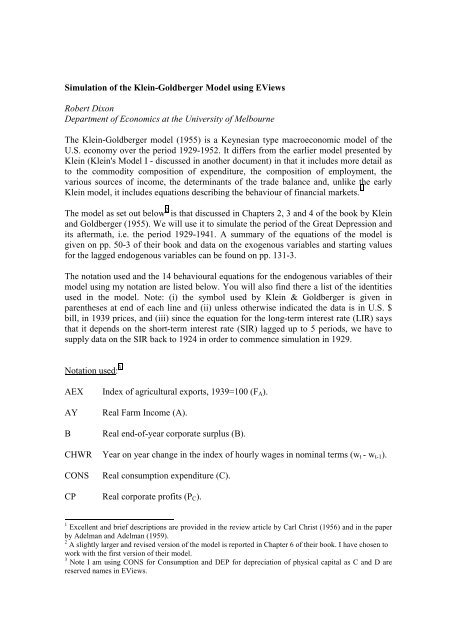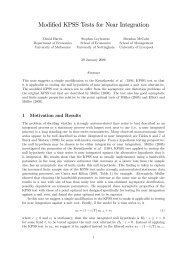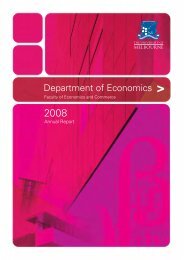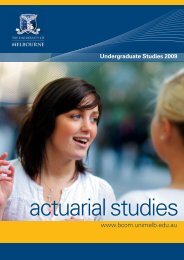Simulation of the Klein-Goldberger Model using EViews Robert ...
Simulation of the Klein-Goldberger Model using EViews Robert ...
Simulation of the Klein-Goldberger Model using EViews Robert ...
You also want an ePaper? Increase the reach of your titles
YUMPU automatically turns print PDFs into web optimized ePapers that Google loves.
<strong>Simulation</strong> <strong>of</strong> <strong>the</strong> <strong>Klein</strong>-<strong>Goldberger</strong> <strong>Model</strong> <strong>using</strong> <strong>EViews</strong><br />
<strong>Robert</strong> Dixon<br />
Department <strong>of</strong> Economics at <strong>the</strong> University <strong>of</strong> Melbourne<br />
The <strong>Klein</strong>-<strong>Goldberger</strong> model (1955) is a Keynesian type macroeconomic model <strong>of</strong> <strong>the</strong><br />
U.S. economy over <strong>the</strong> period 1929-1952. It differs from <strong>the</strong> earlier model presented by<br />
<strong>Klein</strong> (<strong>Klein</strong>'s <strong>Model</strong> I - discussed in ano<strong>the</strong>r document) in that it includes more detail as<br />
to <strong>the</strong> commodity composition <strong>of</strong> expenditure, <strong>the</strong> composition <strong>of</strong> employment, <strong>the</strong><br />
various sources <strong>of</strong> income, <strong>the</strong> determinants <strong>of</strong> <strong>the</strong> trade balance and, unlike <strong>the</strong> early<br />
<strong>Klein</strong> model, it includes equations describing <strong>the</strong> behaviour <strong>of</strong> financial markets. 1<br />
The model as set out below 2 is that discussed in Chapters 2, 3 and 4 <strong>of</strong> <strong>the</strong> book by <strong>Klein</strong><br />
and <strong>Goldberger</strong> (1955). We will use it to simulate <strong>the</strong> period <strong>of</strong> <strong>the</strong> Great Depression and<br />
its aftermath, i.e. <strong>the</strong> period 1929-1941. A summary <strong>of</strong> <strong>the</strong> equations <strong>of</strong> <strong>the</strong> model is<br />
given on pp. 50-3 <strong>of</strong> <strong>the</strong>ir book and data on <strong>the</strong> exogenous variables and starting values<br />
for <strong>the</strong> lagged endogenous variables can be found on pp. 131-3.<br />
The notation used and <strong>the</strong> 14 behavioural equations for <strong>the</strong> endogenous variables <strong>of</strong> <strong>the</strong>ir<br />
model <strong>using</strong> my notation are listed below. You will also find <strong>the</strong>re a list <strong>of</strong> <strong>the</strong> identities<br />
used in <strong>the</strong> model. Note: (i) <strong>the</strong> symbol used by <strong>Klein</strong> & <strong>Goldberger</strong> is given in<br />
paren<strong>the</strong>ses at end <strong>of</strong> each line and (ii) unless o<strong>the</strong>rwise indicated <strong>the</strong> data is in U.S. $<br />
bill, in 1939 prices, and (iii) since <strong>the</strong> equation for <strong>the</strong> long-term interest rate (LIR) says<br />
that it depends on <strong>the</strong> short-term interest rate (SIR) lagged up to 5 periods, we have to<br />
supply data on <strong>the</strong> SIR back to 1924 in order to commence simulation in 1929.<br />
Notation used: 3<br />
AEX Index <strong>of</strong> agricultural exports, 1939=100 (FA).<br />
AY Real Farm Income (A).<br />
B Real end-<strong>of</strong>-year corporate surplus (B).<br />
CHWR Year on year change in <strong>the</strong> index <strong>of</strong> hourly wages in nominal terms (wt - wt-1).<br />
CONS Real consumption expenditure (C).<br />
CP Real corporate pr<strong>of</strong>its (PC).<br />
1<br />
Excellent and brief descriptions are provided in <strong>the</strong> review article by Carl Christ (1956) and in <strong>the</strong> paper<br />
by Adelman and Adelman (1959).<br />
2<br />
A slightly larger and revised version <strong>of</strong> <strong>the</strong> model is reported in Chapter 6 <strong>of</strong> <strong>the</strong>ir book. I have chosen to<br />
work with <strong>the</strong> first version <strong>of</strong> <strong>the</strong>ir model.<br />
3<br />
Note I am <strong>using</strong> CONS for Consumption and DEP for depreciation <strong>of</strong> physical capital as C and D are<br />
reserved names in <strong>EViews</strong>.
CS Real corporate savings (SP).<br />
DEP Real capital consumption (D).<br />
DLIR Deviation <strong>of</strong> long term interest rate from 2% [ ( − 2.<br />
0)<br />
]<br />
= L<br />
i .<br />
DNWY Real gross disposable non-wage income (P + A + DEP - TP - TA).<br />
DY Real aggregate disposable income (Wl + W2+ P + A - TW - TP - TA ).<br />
EX Real exports (FE).<br />
G Real government expenditure (G).<br />
GNP Real Gross National Product (Y+T+D).<br />
GPI Price index <strong>of</strong> GNP, 1939=100 (p).<br />
GWB Government's Wages Bill in real terms (W2).<br />
H Index <strong>of</strong> hours worked per year, 1939=100 (h).<br />
I Real gross private domestic capital formation (I).<br />
IM Real imports (FI).<br />
IMPI Index <strong>of</strong> prices <strong>of</strong> imports, 1939=100 (PI).<br />
K Real end-<strong>of</strong>-year stock <strong>of</strong> private capital (K).<br />
Ll Real end-<strong>of</strong>-year liquid assets held by persons (L1).<br />
L2 Real end-<strong>of</strong>-year liquid assets held by businesses (L2).<br />
LIR Long term interest rate (iL).<br />
N Number <strong>of</strong> persons in <strong>the</strong> labour force (N)<br />
NCDY Real non-corporate disposable income (Wl + W2+ P + A - TW- TP - SP - TA).<br />
NCP Real corporate pr<strong>of</strong>its net <strong>of</strong> tax (PC – TC).<br />
NE Number <strong>of</strong> non-farm entrepreneurs (NE)<br />
NF Number <strong>of</strong> farm operators (NF)<br />
NFDY Real non-farm disposable income (Wl + W2 + P - SP - TW - TP ).<br />
2
NG Number <strong>of</strong> government employees (NG)<br />
NIT Real net indirect taxes (T).<br />
NU Number unemployed (N - NW - NE - NF).<br />
NW Number <strong>of</strong> wage and salary earners (NW).<br />
P Real non-wage non-farm income (P).<br />
PCSIR Percentage change in <strong>the</strong> short-term interest rate [ ( ) ) ]<br />
* i i<br />
100 i − .<br />
PLI Index <strong>of</strong> labour input in private sector (h(NW - NG + NE + NF)).<br />
PSO Real output <strong>of</strong> <strong>the</strong> private sector (Y + T + D - W2).<br />
POP Number <strong>of</strong> persons in <strong>the</strong> United States (NP).<br />
PWB Wages-bill <strong>of</strong> <strong>the</strong> private sector in real terms (W1).<br />
R Excess reserve <strong>of</strong> banks as a percentage <strong>of</strong> total reserves (R).<br />
SIR Short-term interest rate (iS).<br />
TA Net taxes on farm income in real terms (TA).<br />
TC Corporate income taxes in real terms (TC).<br />
1 1 /<br />
st − st−<br />
st<br />
TP Net taxes associated with non-wage non-farm income in real terms (TP).<br />
TW Net taxes associated with wage and salary income in real terms (TW).<br />
TIME time index, measured in years, 1929=0 (t).<br />
WR Index <strong>of</strong> hourly wages (w).<br />
Equations in <strong>the</strong> <strong>Klein</strong> -<strong>Goldberger</strong> <strong>Model</strong>: 4<br />
CONS = -34.5+0.62*(PWB+GWB-TW)+0.46*(P-CS-TP) +0.39*(AY-TA)<br />
+0.23*CONS(-1)+0.024*L1(-1)+0.36*POP<br />
I = -16.8+0.76*DNWY(-1)-0.14*K(-1)+0.14*L2(-1)<br />
4 Since <strong>EViews</strong> will only allow an endogenous variable to appear once on <strong>the</strong> left-hand side <strong>of</strong> an equation<br />
in <strong>the</strong> model, I have written <strong>Klein</strong> and <strong>Goldberger</strong>'s equation (7) as an expression not for Private Sector<br />
Output but as an expression for <strong>the</strong> amount <strong>of</strong> labour input required by <strong>the</strong> private sector.<br />
3
CS = -2.42+0.86*NCP-0.30*(NCP(-1)-CS(-1))-0.014*B(-1)<br />
CP = -8.34+0.71*P<br />
DEP = 11.46+0.14*((K+K(-1))/2)<br />
PWB = -2.70+0.36*PSO+0.14*PSO(-1)+0.16*TIME<br />
PLI = (PSO+31.98-0.076*((K+K(-1))/2)-1.90*TIME)/2.31<br />
CHWR = 4.11-0.75*NU+0.56*(GPI(-1)-GPI(-2))+0.56*TIME<br />
IM = 2.09+0.0087*DY*(GPI/IMPI)+0.24*IM(-1)<br />
AY = -4.53+0.25*NFDY-0.13*NFDY(-1)+0.0096*AEX<br />
L1 = 0.14*NCDY+(75.0/(DLIR^0.84))<br />
L2 = -0.77+0.24*PWB-0.69*SIR-0.27*(GPI-GPI(-1))+0.64*L2(-1)<br />
LIR = 2.66+0.46*SIR(-3)+0.23*SIR(-5)<br />
PCSIR = 6.42-0.55*R<br />
DLIR = LIR-2.0<br />
GNP = CONS+I+G+EX-IM<br />
K = K(-1)+I-DEP<br />
B = B(-1)+CS<br />
PSO = CONS+I+EX-IM+(G-GWB)<br />
DNWY = P+AY-TP-TA+DEP<br />
NCP = CP-TC<br />
NW = ((PLI-NE-NF)/H)+NG<br />
NU = N-NW-NE-NF<br />
NFDY = PWB+GWB+P-CS-TW-TP<br />
P = PSO-AY-DEP-PWB-NIT<br />
DY = (PWB+GWB-TW)+(P-TP)+(AY-TA)<br />
4
NCDY = DY-CS<br />
SIR = ((PCSIR/100)*SIR(-1))+SIR(-1)<br />
WR = WR(-1)+CHWR<br />
GPI = WR/((PWB+GWB)/(H*NW))<br />
Historical <strong>Simulation</strong><br />
The file containing <strong>the</strong> equations in <strong>the</strong> <strong>Klein</strong>-<strong>Goldberger</strong> model and <strong>the</strong> relevant data for<br />
<strong>the</strong> U.S economy over <strong>the</strong> period 1929-41 is named kg.wfl. It may be downloaded to<br />
your computer and <strong>the</strong>n run <strong>using</strong> <strong>EViews</strong>. The model is complicated to solve as it<br />
contains some non-linearities. Don't be surprised if it takes a minute or so to solve <strong>the</strong><br />
model and store values <strong>of</strong> <strong>the</strong> endogenous variables.<br />
The graph given below depicts actual 5 GNP (solid line) and simulated GNP (dotted line)<br />
over <strong>the</strong> period 1929-41. Clearly <strong>the</strong> model tracks actual experience much better than did<br />
<strong>Klein</strong>'s earlier model (<strong>Klein</strong> <strong>Model</strong> 1).<br />
120<br />
110<br />
100<br />
90<br />
80<br />
70<br />
60<br />
29 30 31 32 33 34 35 36 37 38 39 40 41<br />
------------------------------<br />
5 I have loaded data for Actual GNP into <strong>the</strong> workfile under <strong>the</strong> name AGNP. This is to facilitate<br />
comparisons between simulated and Actual GNP. The data on Actual GNP is not needed in <strong>the</strong> simulation.<br />
5
References<br />
Adelman, I. and F. Adelman (1959), "The Dynamic Properties <strong>of</strong> <strong>the</strong> <strong>Klein</strong>-<strong>Goldberger</strong><br />
<strong>Model</strong>", Econometrica, 27, pp. 596-625.<br />
Christ, C. F. (1956), "Aggregate Econometric <strong>Model</strong>s", American Economic Review, 66,<br />
pp. 385-408.<br />
<strong>Klein</strong>, L. R. and A. S. <strong>Goldberger</strong> (1955), An Econometric <strong>Model</strong> <strong>of</strong> <strong>the</strong> United States<br />
1929-1952, North-Holland.<br />
6







